Steller’s Sea Ape
Posted by: Loren Coleman on July 27th, 2008
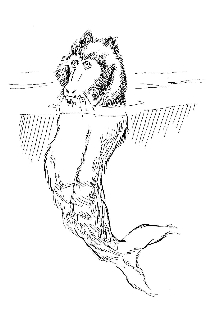
Steller’s Sea Ape, as drawn by Harry Trumbore, from The Field Guide to Bigfoot and Other Mystery Primates (2006: 64-65).
A good overview of the expedition leading to the remarkable sighting of what has become known as Steller’s Sea Ape can be found in the November 17, 2005, article in the California Literary Review. The essay is by Peter Bridges, former U.S. ambassador to Somalia, and is about the animal discoveries made by naturalist Georg Wilhelm Steller.
Bridges writes that:
In January 1738, Steller set out from St. Petersburg on a five-thousand mile journey across European Russia and Siberia to Kamchatka on the Pacific Ocean. His assignment was to study plants, animals and minerals in the empire’s eastern reaches….
And later relates that on August 10, 1741:
One smallish fur-bearing creature that Steller reported sighting at sea has never been seen since then. It was a playful animal with a head like a dog and a fat hairy body, and it cavorted around the ship for two hours. Steller called it a sea ape; he thought it must be an oceangoing primate. Today’s cryptozoologists keep Steller’s sea ape in their list of mysterious mammals, along with the Asian Yeti and American Bigfoot. Most people think it must have been a monk seal.
The Hawaiian monk seal hypothesis may not be as widely accepted as Bridges records. Cryptozoologist Roy Mackal, for example, in his 1980 book, Searching for Hidden Animals, felt the Steller’s Sea Ape might be a juvenile specimen of an unknown long-necked pinniped. Steller himself related it to the Danish Sea Monkey, Simia marina danica.
According to biographer Dean Littlepage in his Steller’s Island: Adventures of a Pioneer Naturalist in Alaska (The Mountaineers Books, 2006), the most likely explanation for the sea ape is a young Northern Fur Seal. Their forelimbs are set back far enough on their torso that they might have been obscured below the waterline, and the “shark-like” tail might have been the animal’s hind flippers. Steller was already familiar with fur seals, but Littlepage speculates that poor lighting during the lengthiest encounter with a probable juvenile could account for the misidentification.
The Field Guide to Bigfoot and Other Mystery Primates (2006: 64-65) notes the sighting was recorded off the Shuinagin Islands, Alaska. The book positively reconsiders Steller’s notion that the animal may have, indeed, been – only “possibly” – a sea-going primate, a merbeing. Of course, that is an outlandish idea, projected in the book due to editorial demands for diversity of content, imagery, and discussion (i.e. that is a long story). The unknown cryptid pinniped notion is conservatively more realistic.
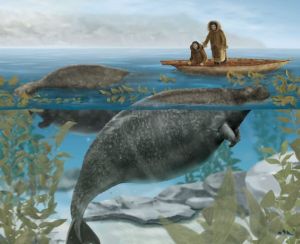
Steller, of course, is associated with one known marine animal that still is of keen interest to cryptozoology. Steller’s sea cow (Hydrodamalis gigas) was discovered in 1741, declared extinct in 1768, but infrequently reported since then, as a cryptid.
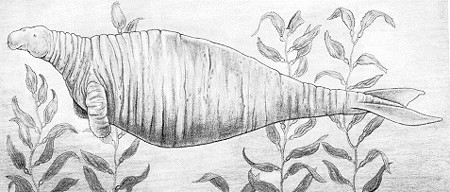

Steller’s Sea Cow, as drawn by Georg Steller.
Steller’s name also remains on many species that he discovered, including Steller’s Sea Raven (a cryptid cormorant-like bird never verified by formal zoology with a specimen), Steller’s Jay, Steller’s Eider, Steller’s Sea-Eagle, and Steller’s Sea Lion.
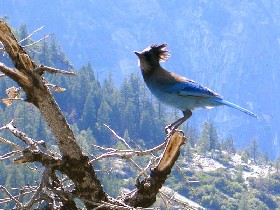

Steller’s Jay (Cyanocitta stelleri).

Steller’s Sea Eagle (Haliaeetus pelagicus).

Steller’s Eider (Polysticta stelleri).
[Steller’s] gumboot chiton (Cryptochiton stelleri).
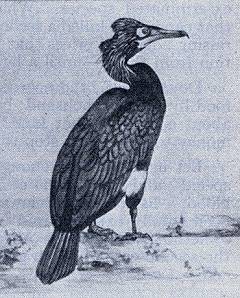
Spectacled cormorant or Pallas’ cormorant (Phalacrocorax perspicillatus) was also discovered in the Aleutian Islands by Georg Steller while exploring with Vitus Bering in 1741. Steller discovered the large, black birds while shipwrecked on a tiny island in the western Aleutians. This island was later named Bering Island because Vitus Bering and many of his crew died there during the long winter after the shipwreck. The spectacled cormorant was extinct within about a century. Steller’s records, six specimens, and two skeletons are the only evidence that this species existed fewer than 200 years ago. Steller was the only naturalist to see the spectacled cormorant alive.
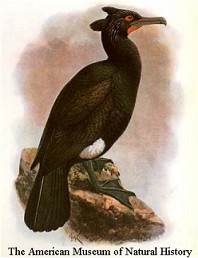
He even discovered a pinniped.
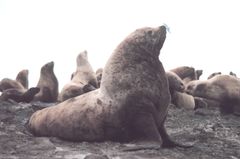
Steller sea lion (Eumetopias jubatus).
Steller, needless to say, was a great naturalist and keen observer. There is little doubt he saw his “Sea Ape.”
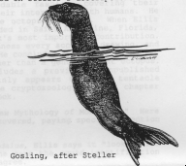
The question remains, what was Steller’s Sea Ape? What do you think?
About Loren Coleman
Loren Coleman is one of the world’s leading cryptozoologists, some say “the” leading living cryptozoologist. Certainly, he is acknowledged as the current living American researcher and writer who has most popularized cryptozoology in the late 20th and early 21st centuries.
Starting his fieldwork and investigations in 1960, after traveling and trekking extensively in pursuit of cryptozoological mysteries, Coleman began writing to share his experiences in 1969. An honorary member of Ivan T. Sanderson’s Society for the Investigation of the Unexplained in the 1970s, Coleman has been bestowed with similar honorary memberships of the North Idaho College Cryptozoology Club in 1983, and in subsequent years, that of the British Columbia Scientific Cryptozoology Club, CryptoSafari International, and other international organizations. He was also a Life Member and Benefactor of the International Society of Cryptozoology (now-defunct).
Loren Coleman’s daily blog, as a member of the Cryptomundo Team, served as an ongoing avenue of communication for the ever-growing body of cryptozoo news from 2005 through 2013. He returned as an infrequent contributor beginning Halloween week of 2015.
Coleman is the founder in 2003, and current director of the International Cryptozoology Museum in Portland, Maine.










Behavior and appearance sound very much like a seal, or possibly a sea otter.
My first thought was a sea otter. They would have the arms and hands that would help to distinguish a primate, and fit the label of “fur-bearing”. But certainly Stellar would have been familiar with those, as well as any pinniped species. Perhaps what we today refer to as a “Snow Monkey” (Japanese Macaque) had a larger range historically? One having been swept out to sea would probably wanted to get in the boat, and that would have kept it around for a few hours!
Very peeved, disgruntled and mutated seal? Sea lion on steroids?
If I had to pick a hypothesis, it would be the lost monk seal. That said, it’s not definitive. We don’t know for certain what this thing was, and I suspect we never will. It is possible, given the dearth of similar sightings, that, as with the sea cow and the spectacled cormorant, Steller was the only naturalist to witness alive an animal that has since disappeared.
In part I agree with Matt Bille, in that it was likely a sighting of what may have been the last of what is now an extinct creature. However, as to the identity of that creature, I suspect it may have been a kind of unusually large otter now and forevermore unknown.
This is one I think must be the last sighting of a now extinct species. When such a noted naturalist whose name is now written in stone, describes an animal fully expecting to see exampled of it again, AND the list of suspects are all animals that he should be familliar with, by observation or description, you are almost certainly dealing with something real.
Ellis suggested that, if this species had been met with in the North Atlantic, it would have likely been identified with the giant sea mink, Mustela macrodon or Neovison macrodon (extinct ca. 1860). It seems to me, though, that the appearance of a sharklike tail is more likely to have been the hind flippers of a pinniped than the hind legs and tail of a mustelid. (If you are positing a marine primate, I suppose it could have evolved all the way to a bilobate tail, but it seems unlikely, since no other mammal outside the cetaceans has done so.)
MattBille: I’m with you. Except.
Steller was a naturalist of obvious ability. I don’t think you just palm this off to a seal and tough lighting conditions.
Some things are just that rare; and with this one, doesn’t look as if we’ll ever know.
But I’d bet some lunch money ‘most people’ are wrong on this one. When a naturalist has hours to record his observation, I don’t think anyone who wasn’t there is a better witness.
I agree whole heartedly with DWA. Steller was a superb observer and in a manner of speaking one of the first really modern naturalists. His biography is compelling. From what I’ve read I can’t say which I find more hard to believe; that he “made it up to sell his books” or that he miss-identified a species with which he undoubtedly had quite a bit of familiarity. I’m pretty sure that even an amateur like myself, if given the opportunity for a sighting over a couple of hours would be able to discern between otter and seal or sealion and some other un-described seal.
The notion that species sometimes are rare even within their range, sometimes limited by instinct to habitat regugias that persist while the conditions for which they are adapted are largely gone, is a valid one and one can only think it would have been even more likely in the past. The first wave of commercial resource harvest in that part of the world was a ferocious and devastating event, cleaning out entire bays of their resident sea otters in a most efficient and cold blooded attention to maximum profit. That populations of rare endemics could have been eliminated before the arrival of modern biologist who would typically travel with commercial vessels after the initial slaughter and trade routes were established (and probably relieved of some of its local populations, especially fur bearers) seems to me more likely than not considering the sparse evidence we have even for the sad handfull of Steller’s namesakes,as prominent and conspicuous as they seemingly were.
Living and travelling through a bit of Alaska I have a feeling for how remote parts of Alaska are, though I’ve never been out to the Aleutians or to Siberia (yet), and understand that even by Alaskan standards some of those little specks out in the ocean are rarely observed at length and it is just too tantalizing to not permit the possibility that a small refugia has been overlooked.
I’d suspect the latest assault on marine mammals in the form of plastic debris rafts is not making it any more likely that they could have survived, but if not there, I wouldn’t be able to hazard a guess as to where or how.
I can see why people could assume it was a monk seal or any other type of seal that Steller saw, but let’s face it, someone with that experience no-matter how bad the lighting would not have described a seal just has having a head like a dog and a fat hairy body, having watched it ‘play’ around the ship for two hours. Surely he would have described it as appearing seal-like?
Given the fact that it was two hours, there should have been enough light to observe it to begin with at least and the two hours afterwards would have helped observe it no matter what the conditions. In reality, I can see only three options here:
1. It was a land-based animal, washed out to sea or even fallen off of their own ship, possibly having been hidden away somewhere on the bow or livestock for food (not likely any land based animal would swim around the ship in a playful way for two hours, it would be wanting to survive and probably panic-stricken to the point of freezing).
2. Steller indeed witnessed a so-called mer-being. The idea behind the legendary ‘mermaid’ is not that far-fetched and to be honest I find it quite likely that a primate of some kind, be it closely related to us or not, would have eventually evolved to live in or regularly access the sea, many other animals did, why not primates?
3. Steller was telling a fib… Perhaps our friend Steller was in fact using his notoriety as a professional to spread claims of amazing creatures. If I were to come running out of the woods screaming ‘I’ve found bigfoot’, people would take it with a pinch of salt and come to the conclusion that I’m ‘just another nutter’… However, if the pope came running out of the woods screaming the same thing, people would be more inclined to believe it or check it out for themselves.
At the end of the day, who knows, the species is probably extinct now anyway much as the many other unknown and never-to-be-seen creatures we’ve missed out on through our own stupidity as a species.
DWA- Yes, some things are that rare. A lot of people don’t realize that there are some species that are known from only a single specimen. Makes one think, what was it that Steller saw? Part of me thinks it was, like others here have postulated, a known animal that maybe fell outside of the usual physical dimensions or was an unusual individual in some respect. However, part of me also keeps open the notion that perhaps Steller saw some new type of very rare animal.
It’s sad that we may never know, and that the Steller’s Sea Ape may be extinct, to forever go down in history as an oddity.
What’s also interesting to me is that we have a man who reliably catalogued many species that are known today, yet when he wrote of one that does not fit into our paradigm of what we know about, people begin to doubt his observations and disregars the sighting as a misidentification or fabrication. I for one think that considering Steller’s status as a good naturalist, perhaps he saw exactly what he says he saw, it is an officially undocumented animal without a specimen, and that perhaps we should not try to hard to shoehorn his sighting into a known explanation. So for me, the Steller’s Sea Ape remains a compelling, if unexplained, curiosity.
Mystery Man’s comment regarding the surprising number of species represented by just a single specimen, or even part of a specimen such as with the Himalayan Blue Bear and the Atlantic Sea Mink, brings to my mind the prospects of finding remains of previously unverified species as the relatively shallow areas in the Bering Sea which were until only a few thousand years ago above sea level and home to many species including ourown and maybe even affiliated hominins, become more and more explored using underwater robots to examine likely places where bones and artifacts could reasonably be found relatively intact. Already places that have been long undisturbed, that are admittedly easier to access even when remote, such as the shallow areas along the Arabian Penninsula, are coming under scrutiny using modern remote sensing devices and resulting in some interesting finds that will no doubt give us insight into the long lost coastal ecosystems and the animals that dominated the continental margins for so long during the pleistocene and earlier. I know you, Loren, enjoy Darren Naishe’s blog, Tetrapod Zoology and his current examination of some spectacularly shaped skulls of long extinct cetaceans takes a look at the astonishing diversity in morphology of some now extinct populations is great stuff.
Leave the country for one week and so missed this post. My favorite cryptid. Better late than never to post a resonse.
Done extensive research on this topic. If I ever write a crypid book, this sighting alone would take up 50+ pages.
I can confidently tell you what Steller did NOT see.
1. Any sea otter or any other mustelid. The sighting took place 150-160 miles from any land.
2. Any otarid (eared seal). Not any sea lion or any fur seal. Steller described the creatures locomotion. It swam like a shark.
And I take issue with the idea Steller was the sole witness to some marine mammal now extinct. That’s merely whimsical thinking. In all recorded history, the only marine mammals that go extinct, go by the hand of mankind. And all are well documented.
I can confidently tell you what Steller DID see.
1. Some species of phocid.
I happen to think that by far, the must likely explanation is that what Steller saw was a juvenile male Hawaiian monk seal. And remember, the monk seal is a southern, not a northern phocid. There are small but distinct differences in appearance between them. And Steller never ever saw a southern phocid in his life.
Thanks for the topic, Loren. Enjoyed reading everything, you included.
Chris Orrick
Does this mean I have to send another $50? 🙂
Corrick, Those are very interesting perspectives.
As for the whimsy in the idea of Steller being the only witness to a species, southern phocid or otherwise, that coincidentally went extinct shortly thereafter, I don’t think it’s suggested that that is the case exactly, but historically we know that the following waves of fur hunting sailors and highly skilled and motivated eskimos left little in their wakes and they might not have thought much of a funny-looking kind of sea ape, or whatever it was, as the pelts were collected and tossed into a pile for processing so the merchants could bid on them for purchase to be sold in the finest markets of the world. It would just be an odd pelt and probably not what the buyer expected and not frequently encountered enough to raise any concerns.
Perhaps, in many ways we should consider ourselves lucky that Steller was there and and saw one of these remaining members of a now presmably vanished and possibly never numerous in-conspicuous creature. Steller’s being there at all was a bit of a fluke in certain respects given the overall story of his journeys.
Too bad nobody like Steller, with the mindset, experience and drive to scientifically describe and inventory what was in the northeast Atlantic, and along the north-east coast of North America, was along with the first commercial visitors to the grand banks in the north Atlantic. It would be a while before a naturalist with the talent and understanding of Steller would get there, and by then at least one species we know of, the sea-mink, another marine mustalid, was aleady gone. The sea mink’s fur was, like the pacific otter’s, very sought-after and its supply supported a lucrative market in Europe and yet there is no description of the animal of what it was like when it was alive by any naturalist (that I’ve ever heard of). When the population of sea-mink was too low to meet the demand, a sustitute fur-bearing animal with similar fur was targeted for harvest and marketted under the name by which the sea mink was known and by which it is known today; the fisher (a terrestrial animal preys on squirrels).
I see what you mean about Steller’s never having had seen a southern seal before, so maybe that is possible, but given his astute and objective descriptions and insight from his life’s work for which he is noted, it seem odd to me that even any seal, monk seal or fur seal (I note the long whiskers to which he alludes) would have so mislead his speculation.
Anyhow, like you, one of my favorite examples of species about which one can ponder and speculate.
Dogu4,
Thanks for the post!
Apparently you share my interest in both Steller and the sea ape, (though technically Steller called it a sea monkey.)
Have to say, think this vanished species, existed once, but now extinct stuff is simply bad science. More about subliminal confirmation biases than cold facts and reality. And an easy out that can never be disproven.
The sea mink is a bad analogy. It was known, it was well-documented. That it wasn’t scientifically described until the 1890’s is no big deal. The Russian, Lisianski first noted Hawaiian monk seals in 1804, but they weren’t “officially” described until 1896. The fact is these animals were known and existed in historical records. Please name ANY marine mammal or even a terrestrial one bigger than a breadbox in the last 1,000 years where there is evidence they went extinct without documented human knowledge. Because you can’t.
Anyway, understand dogu4, I have REALLY researched Steller’s sea monkey sighting.
And the stray male juvenile Hawaiian monk seal theory is the best one. Wasn’t that Steller just saw one, but he saw it during it’s annual “catastrophic molt” which among other things would certainly give Steller pause from calling it some seal. And yes, the timing of a male juvenile Hawaiian monk seal’s annual “catastrophic molt” fits the date of Steller’s sighting. Perfectly.
Like to hear your reply.
Chris Orrick
corrick says:
“Have to say, think this vanished species, existed once, but now extinct stuff is simply bad science. More about subliminal confirmation biases than cold facts and reality. And an easy out that can never be disproven.”
Well, so is this:
“Please name ANY marine mammal or even a terrestrial one
bigger than a breadbox in the last 1,000 years where there is evidence they went extinct without documented human knowledge. Because you can’t. ”
Know why you can’t? Because SCIENCE DOESN’T KNOW OF ANY. Catch-22! Science, essentially, IS “documented human knowledge.”
Except when somebody documented something – and science never followed up.
There is evidence for more than one species’ existence that was never formally documented or recognized by science.
The English colonial naturalist Mark Catesby painted at least one species – a snake, from a specimen he collected – that never received formal scientific recognition (nor any at all outside of the painting; the specimen didn’t get preserved). This snake was found, Catesby wrote, curled up in the underground root ball of a plant, strange indeed for a snake, don’t you think? Soil scientists say that there is no way to document how many soil-dwelling organisms existed at the time of European settlement, or have gone extinct since.
Too many skeptics have too rosy a view of the omniscience of science. Me? I’m dead certain that there are a number of
species that meet corrick’s standard that science never found out about.
Why?
Not belief or bias; just cold hard reality. The monk-seal possibility is there; that the timing indicates the possibility is something to consider. But so is Steller’s acumen as a naturalist. To suddenly discredit him because what he said kinda sits funny?
Science hasn’t been everywhere people have. And no one but Steller need ever have to have seen this animal for it to have been a real one. Given how much we know of the sea even today, that a critter like this got through the net back then is not only plausible, but given simple common sense, way likely.
Remember the ‘Fiji mermaid’? It turned out to be a complete hoax, but doesn’t it sound similar? There’s this ‘sea ape’; and then the Fiji mermaid was a dead monkey sown to a dried fish.
It really looks like a seal to me… but, according to my calculations I think that steller has possibly seen one or more seals than I thought… But I think it’s location is in Canada… or in any countries or places that are with snow…. In the second or third picture… There are some kimonoes.. Sounds like we need to investigate further..
I personally think that it was an unknown species of Pinnepid. To me, Steller had discovered too many species to have seen a known seal and have misidentified it. Perhaps there is a species of undiscovered seal with monkey characteristics. It would also explain the supposed merbeings.